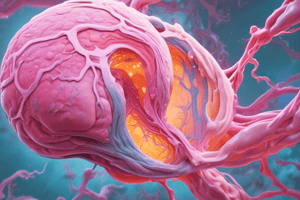Podcast
Questions and Answers
Which of the following changes in fibrocystic change has the highest associated risk for invasive carcinoma?
Which of the following changes in fibrocystic change has the highest associated risk for invasive carcinoma?
- Ductal hyperplasia
- Atypical hyperplasia (correct)
- Sclerosing adenosis
- Fibrosis
What characterizes the appearance of cysts found in fibrocystic changes of the breast?
What characterizes the appearance of cysts found in fibrocystic changes of the breast?
- Irregular calcifications
- Greenish thick discharge
- Blue-dome appearance (correct)
- Solid white masses on imaging
In which population is the fibroadenoma most commonly observed?
In which population is the fibroadenoma most commonly observed?
- Women undergoing hormone therapy
- Postmenopausal women
- Adolescents
- Premenopausal women (correct)
What distinguishes an intraductal papilloma from papillary carcinoma?
What distinguishes an intraductal papilloma from papillary carcinoma?
Which of the following characteristics applies to phyllodes tumors?
Which of the following characteristics applies to phyllodes tumors?
Flashcards
Fibrocystic Change
Fibrocystic Change
A common, hormone-related change in the breast before menopause, characterized by the development of fibrous tissue and cysts. Can cause feelings of lumpy breast tissue.
Intraductal Papilloma
Intraductal Papilloma
A benign breast condition involving a papillary growth within a large duct, often presenting as a bloody nipple discharge in premenopausal women.
Fibroadenoma
Fibroadenoma
The most common benign breast tumor, usually seen in premenopausal women. It's a well-defined, mobile mass that can be sensitive to estrogen.
Phyllodes Tumor
Phyllodes Tumor
Signup and view all the flashcards
Ductal Carcinoma
Ductal Carcinoma
Signup and view all the flashcards
Study Notes
Benign Tumors and Fibrocystic Changes
- Fibrocystic Change:
- Development of fibrosis and cysts in the breast
- Most common in premenopausal women
- Presents as breast tissue irregularity ("lumpy breast"), typically in the upper outer quadrant
- Cysts appear as blue-domed masses on examination
- Some related changes increase risk of invasive carcinoma
- Fibrosis, cysts, and apocrine metaplasia: no increased risk
- Ductal hyperplasia and sclerosing adenosis: 2x increased risk
- Atypical hyperplasia: 5x increased risk
Intraductal Papilloma
- Characteristics:
- Papillary growth within a large milk duct
- Composed of fibrovascular projections lined by epithelial and myoepithelial cells
- Often presents with bloody nipple discharge, especially in premenopausal women
- Important to differentiate from papillary carcinoma, which also presents with bloody nipple discharge
Fibroadenoma
- Characteristics:
- A benign tumor composed of fibrous tissue and glands
- The most common benign breast neoplasm; typically seen in premenopausal women
- Presents as a well-circumscribed, mobile, and marble-like mass
- Estrogen-sensitive; may grow during pregnancy and be painful during menstruation
- Shrinks in size after menopause
- No increased risk of carcinoma
Phyllodes Tumor
- Characteristics:
- Fibroadenoma-like tumor with overgrowth of fibrous component; characteristic "leaf-like" projections on biopsy
- Most commonly found in postmenopausal women
- Can be malignant in some cases
Studying That Suits You
Use AI to generate personalized quizzes and flashcards to suit your learning preferences.




